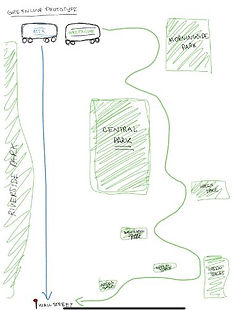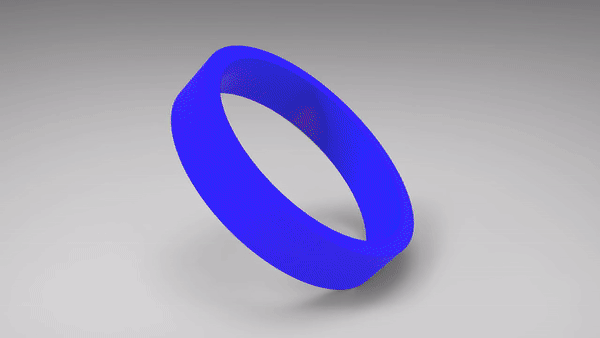top of page
DX Portfolio
Habit@t
In our Human-Centered Design & Innovation course, my team and I tackled the design challenge, "A More Sustainable City." Over 12 weeks, we developed Habit@t—a combination of a physical ring and a digital app designed for New York City residents. Recognizing that New Yorkers often lead high-stress lifestyles with limited exposure to green spaces, Habit@t aims to enhance their well-being by encouraging more interactions with these areas.
Our process involved both primary and secondary research to pinpoint the specific problem. We proposed various solutions and refined our ideas through user interviews, incorporating feedback to iterate our design. This comprehensive approach culminated in the creation of a prototype of Habit@t.
TEAMMATES
Da Hyun Choo, Isaac Dogbegah, Katelyn Lam
INSTRUCTOR
Professor Harry West
DURATION
October 2023 - December 2023
AFFILIATION
Columbia University
CATEGORY
Product Design, UX design
DELIVERABLE
A Physical Product with an App
MY WORK
Ideation, User Interview, User Interface
TOOLS
Figma iMovie Miro
PROTOTYPE VIDEO
STEP ONE : PROBLEM RESEARCH & INSIGHTS
To identify the specific issue related to the sustainability in NYC, we took interviews among residents by asking questions from these three perspectives:
-
The Understanding of Sustainability in NYC
-
Personal Responce and Actions to Sustainability Concerns
-
The Barriers of the Sustainable Life
We collected the wants/needs from interviewees and accordingly generate insights.
Finally, our team selected to focus on the spatial sustainability, how to make full use of the space in NYC. We finally decided the problem statement is: People in NYC don’t experience greenness as much as it would be good for their health.
Wants/Needs
-
The indoor living conditions about the apartment, the lacking of light and ventilation, because the manager of the buildings tried to divide the apartment to have more rooms to make more money
-
More green spaces around the city would encourage more access to nature (ie: not knowing that the spaces exist)
-
It is very unpleasant to walk around NYC due to its cleanliness and that she would always have to get an Uber/Lyft at night because it is too dangerous
-
Tthe preference of working place: people prefer to work from home for the comfortable atmosphere, some prefer go to the office for better device, and some prefer go to somewhere else like starbuck
Insights/Learnings
-
Prioritizing nature in the city and having accessible ways of knowing that it exists
-
Need of sanitary improvements and safe space
-
People’s habit of working is changed, they value work productivity and also personal happiness.
-
The conflict between people’s desire of better living condition and businessmen’s desire of making money
STEP TWO : IDEATION
To address this problem, we brainstormed and put forwared three ideas:
IDEA 1 Greenline Bus
-
Takes regular routes and turns them into more scenic routes that help people identify green spaces
-
Runs through all the green spaces within specific borough which would help people new to NYC explore and simultaneously get an idea of the area surrounding them
-
Would run on a schedule that could be found on an app, which would also have a map of green spaces.

IDEA 2 Green Resource Map
-
The green space resources platform/app to make it easier to find a suitable green space
-
Interactive Map Experience -> Showcases a park specific mapping of NYC
Engage Users to find more information on the green spaces around the city -
Include all the information about where the green spaces, what facilities they can provide and which groups of people are suitable for these green spaces with various tags and images.


IDEA 3 Green Reminder
-
Devices such as Apple Watch can give reminders for clean air or visitations to green spaces
-
Constantly reminding people the need for clean air / walks to green spaces
-
Just like the ‘Stand-up’ feature already in Apple Watch
-
Give out recommendations to local parks with easy routes


STEP THREE: USER INTERVIEW
After the ideation, we conducted another interview so that users can test and evaluate the three products. We also developed matrix and asked "If the three new products are available, please put them and their competitors on the scale" to help the users compare the three ideas and their competitors.
Based on the feedback, we decide to adopt the idea of green reminder. Considering the portability of the product, we decide to design it as a jewllery, like a ring.
A ring plus the attached app functioning as a green reminder, whose name is Habit@t


RATING FROM USERS
STEP FOUR: PRODUCT PROTOTYPE
We further developed the idea 3, building a model for the ring and developing the attached app in Figma. We provided more functions in the app, like nearby green resources, image gallery and green streak, to stimulate residents to have healthy habits.




PROTOTYPE OF THE APP

PROTOTYPE OF THE RING
bottom of page